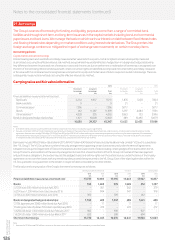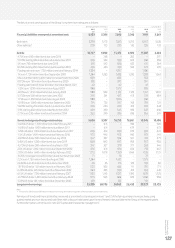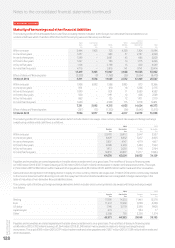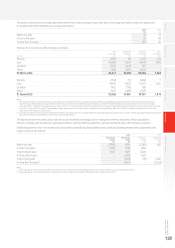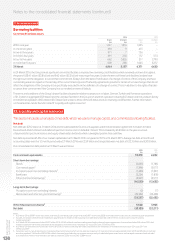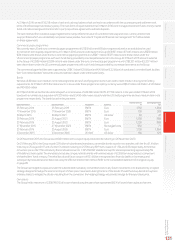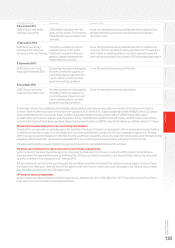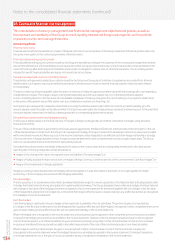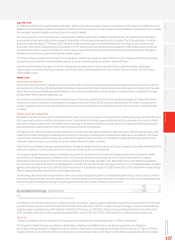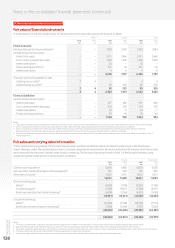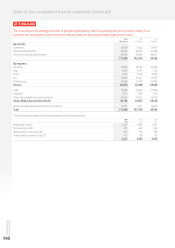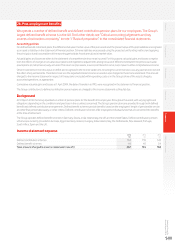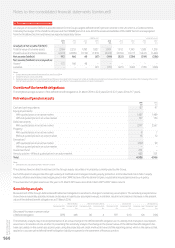Vodafone 2016 Annual Report Download - page 136
Download and view the complete annual report
Please find page 136 of the 2016 Vodafone annual report below. You can navigate through the pages in the report by either clicking on the pages listed below, or by using the keyword search tool below to find specific information within the annual report.
Vodafone Group Plc
Annual Report 2016
134
Notes to the consolidated nancial statements (continued)
23. Capital and nancial risk management
This note details our treasury management and nancial risk management objectives and policies, as well as
theexposure and sensitivity of the Group to credit, liquidity, interest and foreign exchange risk, and the policies
inplace to monitor and manage these risks.
Accounting policies
Financial instruments
Financial assets and nancial liabilities, in respect of nancial instruments, are recognised on the Group’s statement of nancial position when the
Group becomes a party to the contractual provisions of the instrument.
Financial liabilities and equity instruments
Financial liabilities and equity instruments issued by the Group are classied according to the substance of the contractual arrangements entered
into and the denitions of a nancial liability and an equity instrument. An equity instrument is any contract that provides a residual interest in the
assets of the Group after deducting all of its liabilities and includes no obligation to deliver cash or other nancial assets. The accounting policies
adopted for specic nancial liabilities and equity instruments are set out below.
Put option arrangements over non-controlling interest
The potential cash payments related to put options issued by the Group over the equity of subsidiary companies are accounted for as nancial
liabilities when such options may only be settled by exchange of a xed amount of cash or another nancial asset for a xed number of shares
in the subsidiary.
The amount that may become payable under the option on exercise is initially recognised at present value within borrowings with a corresponding
charge directly to equity. The charge to equity is recognised separately as written put options over non-controlling interests, adjacent
to non-controlling interests in the net assets of consolidated subsidiaries. The Group recognises the cost of writing such put options, determined
as the excess of the present value of the option over any consideration received, as a nancing cost.
Such options are subsequently measured at amortised cost, using the effective interest rate method, in order to accrete the liability up to the
amount payable under the option at the date at which it rst becomes exercisable; the charge arising is recorded as a nancing cost. In the event that
the option expires unexercised, the liability is derecognised with a corresponding adjustment to equity.
Derivative nancial instruments and hedge accounting
The Group’s activities expose it to the nancial risks of changes in foreign exchange rates and interest rates which it manages using derivative
nancial instruments.
The use of nancial derivatives is governed by the Group’s policies approved by the Board of Directors, which provide written principles on the use
of nancial derivatives consistent with the Group’s risk management strategy. Changes in values of all derivatives of a nancing nature are included
within investment income and nancing costs in the income statement unless designated in an effective cash ow hedge relationship or a hedge
of a net investment in foreign operations when changes in value are deferred to other comprehensive income or equity respectively. The Group
does not use derivative nancial instruments for speculative purposes.
Derivative nancial instruments are initially measured at fair value on the contract date and are subsequently remeasured to fair value at each
reporting date. The Group designates certain derivatives as:
a hedges of the change of fair value of recognised assets and liabilities (“fair value hedges”); or
a hedges of highly probable forecast transactions or hedges of foreign currency or interest rate risks of rm commitments (“cash ow hedges”); or
a hedges of net investments in foreign operations.
Hedge accounting is discontinued when the hedging instrument expires or is sold, terminated or exercised, or no longer qualies for hedge
accounting, or if the Company chooses to end the hedging relationship.
Fair value hedges
The Group’s policy is to use derivative instruments (primarily interest rate swaps) to convert a proportion of its xed rate debt to oating rates in order
to hedge the interest rate risk arising, principally, from capital market borrowings. The Group designates these as fair value hedges of interest rate risk
with changes in fair value of the hedging instrument recognised in the income statement for the period together with the changes in the fair value
of the hedged item arising from the hedged risk, to the extent the hedge is effective. Gains or losses relating to any ineffective portion are recognised
immediately in the income statement.
Cash ow hedges
Cash ow hedging is used by the Group to hedge certain exposures to variability in future cash ows. The portion of gains or losses relating
to changes in the fair value of derivatives that are designated and qualify as effective cash ow hedges is recognised in other comprehensive income;
gains or losses relating to any ineffective portion are recognised immediately in the income statement.
When the hedged item is recognised in the income statement, amounts previously recognised in other comprehensive income and accumulated
in equity for the hedging instrument are reclassied to the income statement. However, when the hedged transaction results in the recognition
of a non-nancial asset or a non-nancial liability, the gains and losses previously recognised in other comprehensive income and accumulated
in equity are transferred from equity and included in the initial measurement of the cost of the non-nancial asset or non-nancial liability.
When hedge accounting is discontinued, any gain or loss recognised in other comprehensive income at that time remains in equity and
is recognised in the income statement when the hedged transaction is ultimately recognised in the income statement. If a forecast transaction
is no longer expected to occur, the gain or loss accumulated in equity is recognised immediately in the income statement.




